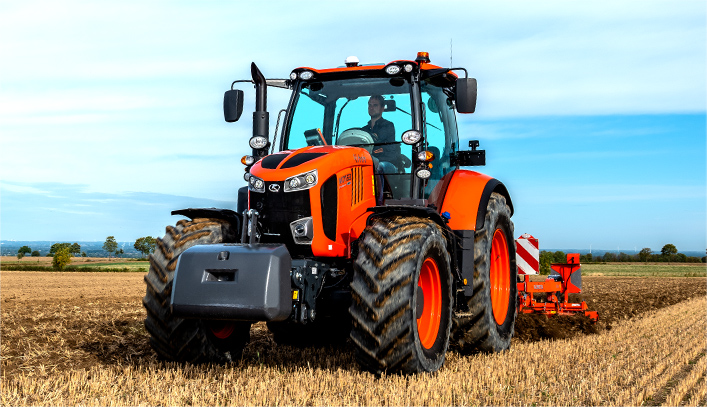03
Kubota Working at the Forefront of Precision Farming in Europe
R&D in the Netherlands

Tractors + implements ICT-enabled integrated control
Implements are considered as the first runner in the European upland farming market; Ploughs for tilling, seeders for planting, mowers for cutting grass, balers for compacting hay, sprayers for sprinkling agricultural chemicals, and spreaders for distributing fertilizers, they are just a few of the diverse implements that have been developed for each aspect of upland farming work. In the tractor business, Kubota is a newcomer to the European upland farming market, but its Group implement manufacturer, KVG has long made its presence known in this field. It has earned a high reputation for its engineering expertise not only in Europe, but also in the international market.
At present, Kubota and KVG are working together to reshape the concept of smart farming, and one of these projects is to exchange information between a tractor and an implement for integrated control that achieves higher-efficiency, yet lower-cost farming. Having a tractor and an implement share the operational data, such as driving speed and number of engine revolutions, makes agricultural work more convenient and comfortable. When baling hay, for instance, the driving speed of a tractor and other parameters can be optimized by determining what the tractor needs to do based on the operating conditions of a baler, and having the implement communicating such data to the tractor. In the case of mowers for cutting grass, the operations of the implements are able to optimally be controlled based on the operational route of the tractor in order to avoid mowing the same area twice. Through such “tractors + implements” combinations, Kubota is making even greater efforts to achieve the optimization of farming.
-

Kverneland Group Mechatronics B.V. in Nieuw-Vennep Amsterdam
Diffusion of the ISOBUS international communications standard is essential for the realization of smart farming
-

From left
Alexander Sassenberg
Director, Sales & Marketing, Kverneland, Group Mechatronics B.V.
Sanne de Voogd
Managing Director, Kverneland Group, Mechatronics B.V.
Ton van der Voort van der Kley
Business Development Director, Kverneland Group Mechatronics B.V.
The key to information communications between tractors and implements is an international standard called ISOBUS. Conceived specifically for linking tractors with implements of any brand, ISOBUS is a globally shared communications standard. It was KVG that came up with the idea of ISOBUS, and it played the central role in developing the standard. One of the key individuals responsible for making this happen was Ton van der Voort van der Kley, who is currently Business Development Director at KVG Mechatronics B.V.
“We first embarked on R&D for electronic implements in the beginning of the 1980s,” he noted. “It then occurred to us that we needed a common platform that would allow a smooth connection and exchange of information between the farm machines of customers and those of other brands, and this served as the basis for the development of the ISOBUS international standards. By facilitating dialog between tractors and implements of different brands, ISOBUS offers innovative solutions not only to achieve high efficiency and low costs in farming, but also to make controlling farm machinery easier and more convenient.”

Daw Mya Mya Than
CTO, Kverneland Group Mechatronics B.V.
The dedicated efforts of Ton and his team bore fruit in 2008 when the Agricultural Industry Electronics Foundation (AEF) was established as an organization to promote the diffusion and expansion of ISOBUS, after which adoption of the standard by the world's leading manufacturers of tractors and implements gathered pace. Peter van der Vlugt, CTO of KVG Mechatronics B.V., currently serves as chair of the AEF.
“The AEF supports the development of ISOBUS-compatible products by providing state-of-the-art software tools and products, with the goal of achieving global diffusion and expansion of ISOBUS. At present, it is being diffused in Europe, North America, and other parts of the world, but we are still dealing compatibility issues in certain markets. I think that the further spread and expansion of ISOBUS is essential for the evolution of precision farming throughout the world.”
-
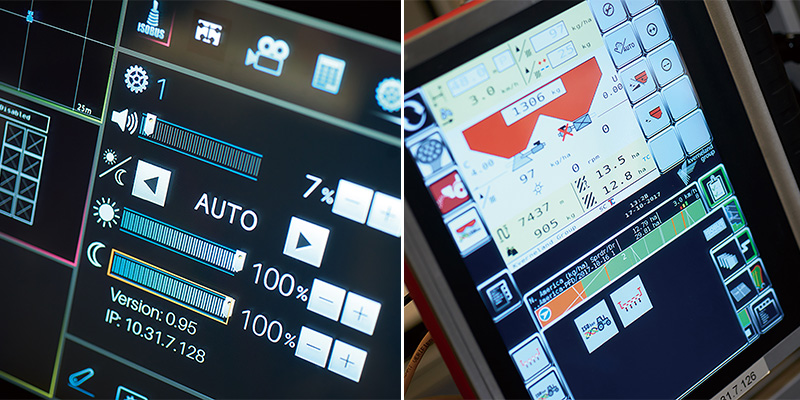
Touchscreen terminal monitor for M7001 and other models -
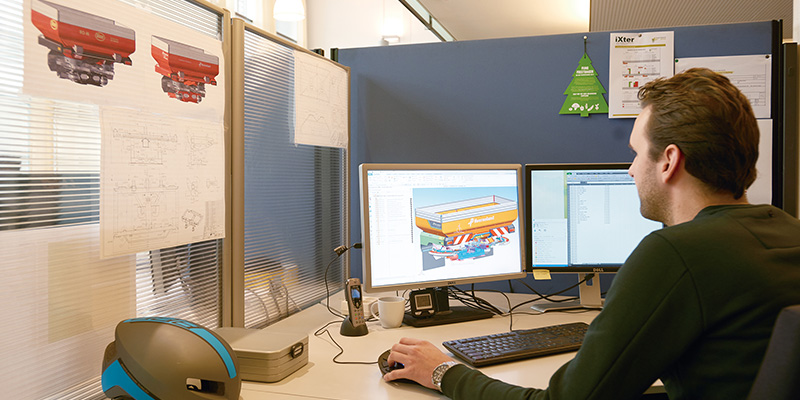
Researchers at Kverneland Group
Mechatronics B.V. work on advanced technologies incorporating cloud services and robotics.
The technology pillars needed for advancement of smart farming
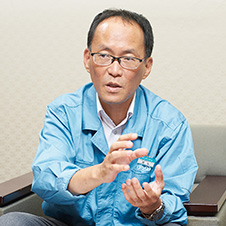
Manager, First Development Section, Instrumentation
and Control Technology Center
ISOBUS provides the basis for smart farming, but there a number of technological breakthroughs are required for the further advancement of such farming. Alexander Sassenberg, Director of Sales and Marketing of Smart Farming Systems at KVG, spoke with us on the topic.
“KVG has identified five technology pillars needed for the strategic smart farming developments,” he said. “They are: 1) ISOBUS, 2) telematics (remote data communication system), 3) smart sensors, 4) smart implements, and 5) cloud data management. If we add more, human interfaces, autonomous driving, and robotics are also elements required for the smart farming of the future. Through research and development of these technological pillars, we hope to develop smart farm machinery that customers will find even easier to use, increase the productivity of our machinery, reduce crop production costs, and contribute to increased world food production.”
In particular, to raise the level of automation of farm machinery using ISOBUS, information must be smoothly integrated and distributed from farm machines to a data management system using cloud technology. Serving as a technological foundation for KVG's promotion of smart farming is the mechatronics technology that it has accumulated over many years. Mechatronics technology is used in sensors and software, and it is at the core of the technologies that support smart farming. Sanne de Voogd, Managing Director of KVG Mechatronics B.V., points out the social significance of smart farming.
“With the growing world population, it is necessary to increase food production using limited resources. Under such circumstances, smart farming practices will play an important role, as they are intended to achieve higher efficiency and labor conservation in farming. This lines up perfectly with the Kubota Group's brand statement of ‘For Earth, For Life' and our business concept of ‘Smart, Efficient, Easy Farming.' You could say that living up to these slogans is truly smart farming.”
Development efforts are also being accelerated on the Japanese side. One such project involves the development of sensors, in which Kubota has a high degree of technological prowess.
“To further develop precision farming, it is necessary to utilize GNSS and have information systems that collect and manage various types of data. We are working hard on advanced research projects to facilitate the use of the growth sensors that are built into such systems.” (Hiroyuki Araki, Manager, First Development Section, Instrumentation and Control Technology Center)
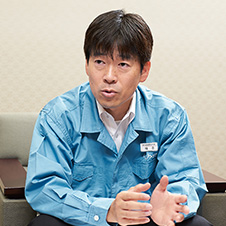
Manager, Electronic Development Office, Vehicle
Base Technology Engineering Department
For example, rather than working field-byfield, in order to enable even more precise segmentation of one tract of land into smaller fields (i.e., meshing), appropriate fertilizer application and agricultural chemical distribution, irrigation, and other activities, accurate measuring (that is, sensing) is required. Another development project being promoted along with sensing accuracy enhancement is the creation of a tractor that runs automatically on the basis of received information.
“To make a tractor that runs automatically and stably for any job and under any conditions, we need to develop a function that supports automatic operation using the Farm Management Information System (FMIS), which manages data from sensors in an integrated manner. This is one of the research topics that we are working on through close cooperation with KVG.” (Susumu Umemoto, Manager, Electronic Development Office, Vehicle Base Technology Engineering Department)
As one can see, a wide variety of technologies for implementation of smart farming are under development. Let us now take a look at the present state of Kubota's smart farming in the European market.
